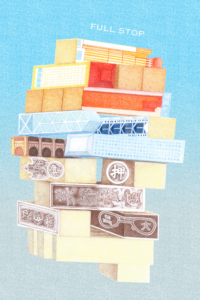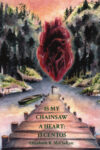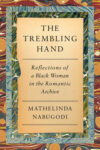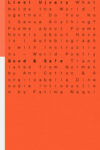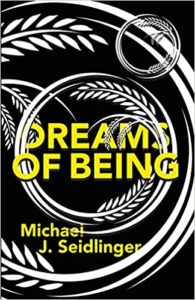
[Maudlin House; 2020]
What would happen if Jiro Ono dreamed of sushi but never became a famous chef? What if he worked at a Benihana in New York City? What if his greatness went unrecognized? The alternate reality of sushi’s most revered chef is the driving premise of Michael J. Seidlinger’s newest book, Dreams of Being. It’s a tightly wound novel that waxes philosophic on artistic identity and creative struggle.
The story of trying and failing is something you don’t want to tell. But you have no choice but to tell it, figuring it may be the only story that’s truly yours.
The story is simple: a writer wanders New York City searching for creative direction and stumbles upon the grand opening of a sushi restaurant in Time Square. In line, he meets Jiro, an enigmatic chef protesting the entire event. Jiro asks pointed questions while revealing little about himself. Feeling it’s the only way to keep Jiro’s attention, the narrator lies about being a documentary filmmaker and agrees to create a documentary that will reveal the yet-to-be-discovered master sushi chef. The book accelerates from there with the narrator’s guise of being a director serving as the stakes for much of the story.
Jiro Ono, as a reminder, is the subject of the real-life documentary, Jiro Dreams of Sushi, a beautiful film detailing his total devotion to the craft and life of creating delicious sushi. A hybrid of fan fiction and historical fiction, Seidlinger’s Jiro story exists in a parallel universe in which the creatively unsuccessful Jiro is paired with an equally unsuccessful writer, making for a unique interpretation of the American dream. While Seidlinger’s fictional version of Jiro exhibits the same laser focus and rigid discipline as the real life counterpart, rugged individualism has only led him to a career at a Benihana. Hard work has not paid off. The writer, meanwhile, is essentially learning to be a filmmaker on the fly after struggling as a wordsmith.
I believed in the fiction I had crafted for ourselves. It’s something I do well, believing in what never existed in the first place.
At its core, Dreams of Being is a book about identity in the face of artistic struggle: the nameless narrator’s false identity and Jiro’s undiscovered identity, specifically. How a person is defined by what they create. What defines the line between a person and the artist, and in turn, the art they make. In this case, sushi. He answers these gradually throughout the book, as the characters bounce from sushi joint to sushi joint, as they prepare for the documentary, as they share meals. Eventually Seidlinger arrives at the concept of shokunin: the artist who devotes their life to their craft and lives a life of tireless practice. This is admirable, sure, and even revered, as shown by real life Jiro in the documentary. But as Seidlinger’s narrator shows, it might be too narrow an interpretation of an artist, and even unattainable for Westerners. While Jiro wants mastery, the narrator desires more.
The artist does not seek only the satisfaction of popularity and praise from others. The artist seeks master of their craft . . . I guess I want nothing more than the satisfaction of being considered a success.
Recognition is the line dividing these two artists and it’s interesting to see how each reconciles with this, of course, if you find that interesting. The struggling artist trope can be a tough sell for a novel, and can be especially hard here because these meditations on artistic identity exist in the singular thought process of the narrator. In the latter half of the book, when tensions should be highest, the reader is denied the satisfying confrontation between the two characters. Instead, Seidlinger focuses on the internal conflict of self.
I just wanted to be a writer. He just wanted to be a chef. The difference is one had succeeded while the other got caught up in dreams of being . . .
Aside from its focus on identity, this is book also about sushi. Extensive portions are devoted to the technical aspects of sushi making and preparation, to umami, to flavor profiles, to the movements of a meal. Seidlinger has done his homework here, or watched Jiro Dreams of Sushi too many times. Likely the latter. Reader be warned: if you don’t like sushi much of this book could read like the whale chapters in Moby Dick. From cuts of fish to techniques, to flavor profiles — for better or worse — Dreams of Being covers it all and more in an effort to show the meticulous nature and singular focus of a devoted artist.
The writing itself reflects this too. Sure, it’s passé to discuss prose in a book review, but the writing in these pages is worth mentioning, not so much for what it does, but what it doesn’t do. Even though Dreams is at times a “writer’s novel” there’s nothing flashy or show-offish about the prose. It’s direct and straightforward in a way that both mimics Jiro’s character and serves the plot. In a way it could almost be called utilitarian. All this is to say Seidlinger lets the focus remain on the two main characters and the substance of their creative passions and struggles.
. . . the passion with which he has devoted his life to a craft, the passion that resounds and rings true . . . the shokunin puts work first, wants nothing more than to be immersed in the peculiarities of their craft.
How far will one character push themselves to be a better artist? And how far will the other push a lie? Dreams of Being answers these questions in ways you’d never expect. It’s not just a book for writers or sushi lovers, it’s a book for ardent dreamers and judicious doers, a book for anyone who has ever taken a risk for something they love.
Kevin Sterne is the author of All Must Go. He is the winner of the Phoebe Journal 2020 fiction contest. His fiction has appeared in The Nervous Breakdown, Maudlin House, Smokelong Quarterly, and other great places. He lives in Chicago.
This post may contain affiliate links.


